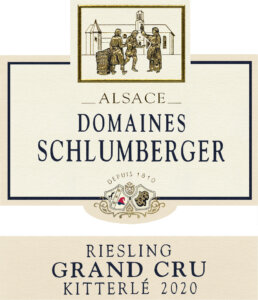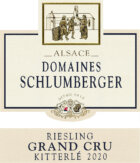History
Ranked among the best wines in the world, the Riesling is one of Alsace’s biggest successes. Introduced in the 15th century, and originating from the Orleanois region, it is different from its German counterpart and from the numerous Riesling, which can now be found a little all over the world. A late-ripening grape variety, it continues to ripen at low temperatures, but gives marvelous results
when there is a sunny, dry, late summer. First distinguished in 1699, Kitterlé has always had an exceptional reputation. Already protected in the middle ages, it has been sold under its own name since 1830.
Location
This volcanic-sandstone plot is on a unique site, on a steeply sloping rocky outcrop facing three ways (south-west, south and south-east). The light, sandy soil, which is kept back by huge dry stonewalls, only gives very low yields (25 to 35 hl/ha)
Wine-making
The grapes are handpicked and whole bunches are pressed. There is static settling of the lees. The wine is fermented in temperature-controlled tuns, followed by raising on the less for 8 months.
Gastronomy
To associate urgently, at the table, with a grilled octopus with lemon and roasted tomatoes, grilled grouper with turmeric and peppers, a lobster in the oven,orange and spice sauce or a goat’s milk cheese, Chabichou type.
Serving temperature: 12°C.
This wine goes well with
Learn more about food & wine pairingTasting
The colour is pale yellow with green reflections, of medium intensity. The disc is shiny, limpid, and transparent. The wine presents youth.
The nose is frank, pleasant, a little restrained. We perceive a dominant scent of citrus fruits, zest of yuzu, lemon, and fine mineral touches of gas.
Aeration amplifies these smells and reveals notes of white flowers, fine vegetal,lemongrass and spices, white pepper, ginger. In the spirit of the vintage, the nose is still reserved. However, the precision and definition of the terroir suggest a great wine in the making.
The attack on the palate is dense, juicy. The full-bodied alcohol support. We evolve on a sharp, saline medium, underlined by pearling. We find the range of aromas of the nose, more assertive. Focused on citrus fruits, yuzu zest, lemon, white flowers, fine vegetal, lemongrass, spices, ginger, white pepper and, always implicitly, this smoky mineral note. We feel a hint of bitterness. The finish has a good length, 9-10 caudalies, as well as a strict vivacity and a slight lingering bitterness.
The balance is sharp, precise. The mineral dimension is complete.
Vertical, saline, endowed with great bitterness, time will allow it to assert itself.
Technical sheet by M. Pascal Leonetti: “Best Sommelier of France 2006” July 2022















